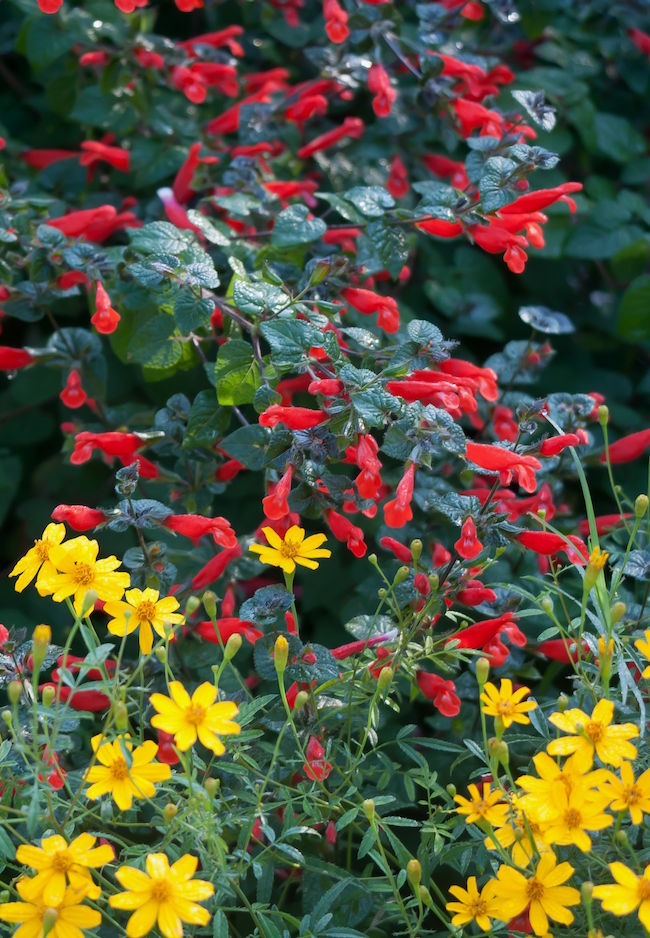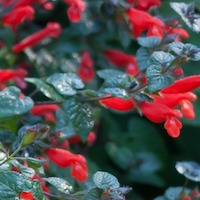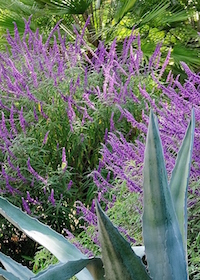The misplaced sage heads up a group of fall-blooming salvias that are absolutely riveting now in the garden. Salvias just may be the favorite collector plants of gardeners in the United States, and rightfully so, as I will explain.
Your first question is probably, “What is the misplaced salvia?” Botanically speaking, it is Salvia disjuncta. It is from Mexico and simply amazing with its saturated fire-engine-red blooms. The blooms number in the hundreds and are mesmerizing.
Our plants at the Coastal Georgia Botanical Gardens in Savannah are around 4 feet tall, but they can reach a staggering 6 feet in height. We have ours partnered with the Copper Canyon daisy, Tagetes lemmonii, another Mexican favorite in the gardens. Visually, this analogous color-schemed partnership has to be one of the most attractive for the fall landscape.
The misplaced sage is truly a short-day bloomer which means it is triggered by shorter day lengths. Some suppliers report blooms starting in late October, but ours started in September. The incredible display lasts until a hard frost.
In addition to misplaced sage (Salvia disjuncta) and Mexican bush sage (Salvia leucantha), two other short-day salvias you may want to consider are orange mountain sage (Salvia regla) and the stunning ‘Red Neck Girl’ (Salvia madrensis), a yellow-flowered forsythia sage. All of the salvias are cold hardy from zones 7 through 10 and can be a tasty treat for the late-season hummingbird.
Our other fall-blooming salvias have been blooming all summer. We were going to have an Autumn Gardenfest in October, but Hurricane Matthew had other plans. To get ready for the fall festival, we counted back seven weeks and pruned back our summer salvias hard.
We are reaping the reward of hard pruning with great displays of the salvias, like the royal purple ‘Amistad,’ a Salvia guaranitica hybrid, and the ‘Mystic Spires Blue,’ a terrific, compact Salvia farinacea and Salvia longispicata hybrid.
It is a mystery to me why everyone doesn’t grow salvias. They are deer-resistant perennials that create excitement in the garden by virtue of their spiky blooms. And they attract hummingbirds and pollinators.
If you live north of zone 7, your first choice would have to be ‘May Night,’ an award-winning Perennial Plant of the Year. It’s cold hardy from zones 4 through 9. Although it might not bloom into the fall, the meadow sage (Salvia pratensis) will, and it is equally cold hardy.
Hopefully, you will give perennial salvias a try. To grow yours, choose a site next spring in full to partial sun for best flowering. Again, our beds here in Savannah get direct afternoon sun. Good drainage improves the chances of a spring return. Cold winters coupled with soggy soil generally mean that the salvias will be history.
To help with drainage issues, prepare the soil before planting by adding three to four inches of organic matter like fine pine bark or compost, and till to a depth of eight to 10 inches. While preparing the bed, incorporate two pounds of a 12-6-6 slow-release fertilizer with minor nutrients. Plant salvias at the same depth they are growing in the container, and space them two to three feet apart or as recommended per the variety and species.
For cottage garden beauty and color or the backyard wildlife habitat, perennial salvias are must-have plants.
Follow me on Twitter @CGBGgardenguru. Learn more about the Coastal Georgia Botanical Gardens at www.CoastalGeorgiaBG.org.









